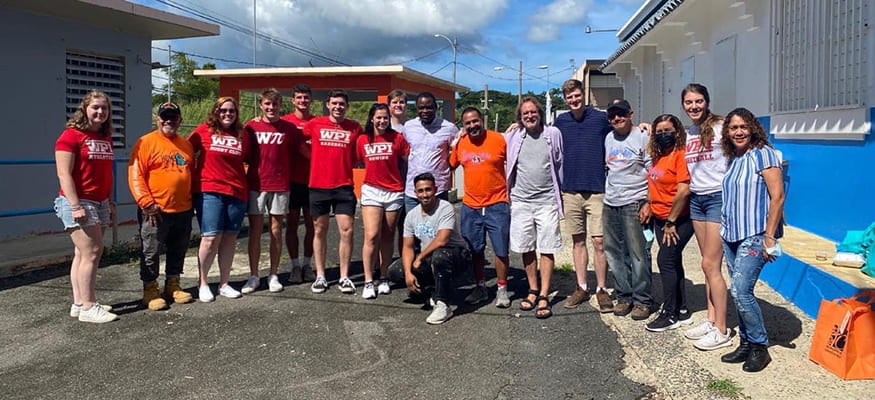A Project Center Close to Home
Students build a forest classroom at the Farm Stay Project Center in Paxton.
Read StoryIn Spring 2021, sensing that pandemic-fueled international travel restrictions were not going away anytime soon, Professor Emeritus Scott Jiusto and Associate Professor Gbetonmasse Somasse began looking for an alternative travel experience for students scheduled to head to the Cape Town, South Africa, Project Center they co-direct. They weren’t alone. Many global project center directors were faced with the same conundrum, recognizing that—for many students—leaving campus and traveling abroad are essential parts of the distinctive Interactive Qualifying Project experience.
They considered all domestic alternatives and were intrigued by the Puerto Rico Project Center (PRPC), a well-established center that has hosted groups of WPI students for more than 30 years.
“The Puerto Rico Project Center offered an opportunity for a cross-cultural experience and to do the same kind of community-engaged work we do in South Africa,” says Jiusto. He approached Assistant Teaching Professor John-Michael Davis, in his first year as the PRPC director, who jumped at the chance to collaborate and learn from the more experienced Jiusto.

The team worked with Kent Rissmiller and the Global Experience Office to ensure travel to Puerto Rico was even possible. Then in June 2021, Jiusto and Davis, now co-directors of PRPC, headed to the U.S. territory to meet with local nonprofit groups to identify 11 or 12 new projects for displaced students, including some who were also being redirected from the Albania Project Center.
“Many were new sponsors because we knew the regular cycle of Puerto Rico students come in D-Term and we didn’t want to overwhelm those sponsors by asking them to do it twice,” says Jiusto. They met with many small, grassroots organizations that were working on similar themes: resilience in the face of environmental disasters brought on by climate change; and repurposing of the hundreds of abandoned schools throughout the island, buildings closed due to residents migrating to mainland United States, government austerity measures, or occasional corruption.
“These schools were shut down in a very top-down manner with little community engagement. Some are being sold to developers, but it’s causing all sorts of access problems,” says Davis. “It’s really inspiring to see all these small organizations pull together to reclaim schools that have been in their communities, in some cases over 100 years.”
Two student teams worked with local leaders who dreamed of turning an abandoned school into the Cubuy-Lomas Community Services & Development Center, where residents can access health care, education and job training, computer services, and clean water, especially in emergencies.
“The center will provide the community with resources to become more resilient, particularly to natural disasters such as hurricanes, and also to provide additional services to community members on a day-to-day basis,” says Somasse, who served as an advisor to both projects.
One team focused on ways to harvest clean, potable water and generate off-grid power in the case of emergencies. A second team built a website for the center that includes videos, a 360-degree tour, and computer-aided design models to promote the center and aid in fundraising.
The best part of my experience was having the opportunity to meet such inspiring and ambitious people such as our project sponsors, who truly have big hearts.
Talia Mamayek ’23
“When we first came down and saw them in July, it was just a building and two guys who had a vision. There wasn’t even paint on the walls,” says Davis. Due to the tenacity of the sponsors, the building is now ready to host businesses, such as a pharmacy or health care center.
Talia Mamayek ’23, whose team worked on the water and power resiliency project, says the spirit of the local residents is what she will remember most.
“The best part of my experience was having the opportunity to meet such inspiring and ambitious people such as our project sponsors, who truly have big hearts,” she says. “I was also exposed to the complexities and challenges that most nonprofits face with gaining support for their initiatives, spreading the word, and envisioning the long-term social impact of their work, such as reducing vulnerability and building resilience for their community.”
Robert Hersh, instructor/lecturer, and Leslie Dodson, assistant teaching professor, advised other PRPC teams that worked on emergency preparedness, mangrove reforestation outreach, and recycling efforts in the town of Piñones; helped strengthen the volunteer program in the Caño Martín Peña area; provided GIS data for Para La Naturaleza, an organization working to conserve natural protected areas; analyzed the El Yunque National Forest visitor experience in the Rio Sabana Recreation Area; and advised the Museo de San Juan on website development to better share the history and culture of Puerto Rico.
“We know that students get a great experience when they work with tiny organizations that value their presence,” says Jiusto. “And we want some thematic foci of what we do, consistent with the Global School’s vision to have more impact with our project centers.”
Six teams are scheduled to return in D-Term, working in four different communities that are wrestling with similar issues.
“One of the cool things is that we’re able to serve as a network and bring these different communities that are struggling with the same challenges into conversation with each other,” Davis says, especially the many groups working to reclaim abandoned schools so they can share ideas and work collectively on policy decisions.
“It’s such a welcoming place, which is part of why we got excited,” says Davis, who notes that going forward they are planning to send teams in both C- and D-Terms, possibly for students in the community climate adaptation master’s program. “The sponsors were really excited and saw the value in just having enthusiastic students showing up on site and pushing the ball forward.”